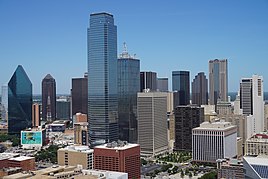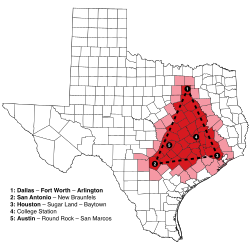|
Texas Triangle
The Texas Triangle is a region of Texas that contains the state's five largest cities and is home to over half of the state's population. The Texas Triangle is formed by the state's four main urban centers, Austin, Dallas-Fort Worth, Houston, and San Antonio, connected by Interstate 45, Interstate 10, and Interstate 35. In 2020, the population of the Texas Triangle reached nearly 21 million following rapid growth across much of Texas.[1] The Texas Triangle is one of eleven megaregions in the United States, clusters of urban areas that share economic and cultural ties. In 2004, the Texas Triangle contained five of the 20 largest cities in the U.S. and was home to more than 70% of all Texans, with a population of 13.8 million.[3] In the next 40 years, the population of the Texas Triangle is projected to increase by more than 65%,[4] or 10 million people, and comprise 78% of all Texans. Additional metropolitan areas in the region include Bryan–College Station, Killeen–Temple–Fort Hood, and Waco. Twelve micropolitan statistical areas are within the Triangle, which includes 66 counties.[5] Beaumont, located east of Houston, has been considered part of the Texas Triangle by numerous studies dating from 2000.[6][7][8][9][10] Burleson County is the center of the Texas Triangle. GeographyThe megaregion is defined in work by America 2050 initiative and others. Dr. Robert Lang of the Metropolitan Institute at Virginia Tech characterized Dallas–Fort Worth as one of the earliest recognized megapolitans. Although each city is distinct, Dallas and Fort Worth developed closely enough to form the urban area widely known as the Metroplex. The 60,000-square-mile (160,000 km2) region contains most of the state's largest cities and metropolitan areas, and in 2008 had a total of 17 million people and by 2020 had grown to nearly 21 million,[1] nearly 75% of Texas's total population.[11] The region is comparable to Florida in population and comparable to Georgia in area, but the Texas Triangle comprises less than a quarter of Texas's total land area. According to the University of Texas at Austin Center for Sustainable Development, "the Texas Triangle has three sides measuring 271, 198, and 241 miles in ground distance."[12] Metropolitan areas
Micropolitan areas
Triangle countiesThe Texas Triangle contains 65 counties. They are Anderson, Atascosa, Austin, Bandera, Bastrop, Bell, Bexar, Blanco, Bosque, Brazoria, Brazos, Burleson, Burnet, Caldwell, Chambers, Collin, Colorado, Comal, Coryell, Dallas, Denton, DeWitt, Ellis, Falls, Fayette, Fort Bend, Freestone, Galveston, Gonzales, Grimes, Guadalupe, Harris, Hays, Henderson, Hill, Houston, Jackson, Johnson, Kaufman, Kendall, Lampasas, Lavaca, Lee, Leon, Liberty, Limestone, Madison, McLennan, Medina, Milam, Montgomery, Navarro, Rockwall, Robertson, San Jacinto, Tarrant, Travis, Trinity, Victoria, Walker, Waller, Washington, Wharton, Williamson, and Wilson. PoliticsThe Texas Triangle can be considered one of the more politically left-wing areas in Texas due to the anchoring cities of Houston, San Antonio, Dallas, Austin, and Fort Worth. All of these cities, and their respective counties of Harris, Bexar, Dallas, Travis, and Tarrant, moved towards Joe Biden in 2020, with Biden flipping Tarrant County, which had gone for Donald Trump in 2016. Prior to 2008, with the exception of Austin/Travis and San Antonio/Bexar (the latter a former bellwether/swing county and the former a liberal stronghold), all of these cities/counties were conservative strongholds, having voted for Republican presidential candidates from the 1960s through 2004. This culminated with Barack Obama flipping Dallas, Harris, and Bexar counties to the Democratic party in 2008.[13] Since 1912, Travis County consistently has been a liberal stronghold at the presidential level. During this time, it only backed the Republican candidate six times, all Republican landslides except for 2000. 2000 remains the last time that a Republican presidential candidate captured the county and the last time that a third-party candidate affected the results. This more than likely was due to the somewhat strong showing of third-party candidate Ralph Nader, who polled in a 10.37% vote share, his best in any Texas county, likely due to some Democratic voters voting for Nader instead of for Democratic Party nominee Al Gore.[1] Despite being a liberal stronghold at the presidential level, Travis County has gone Republican more times in Senate races. For example, Kay Bailey Hutchison won the county in all but one of her Senate bids, that being 2006. Ted Cruz would continue the losing streak, losing the county in both his 2012 and 2018 bids. John Cornyn, in all his senate bids since 2002 has never won this county, despite it being his home county, and it is one of two in the Triangle never to have backed him, the other being Dallas County. Travis County also has gone Republican in gubernatorial races, most recently in 1998, when George W. Bush won a second term to the governorship.[citation needed] Despite the five biggest cities in Texas being within the Triangle, there are also a great number of rural, conservative counties in the Triangle. It is in these counties that Republicans poll their best. TransportationThe Texas triangle has also been the subject of rail feasibility studies in particular for high speed rail.[14][15][16] See alsoReferences
External links
|
||||||||||||||||||||||||||





